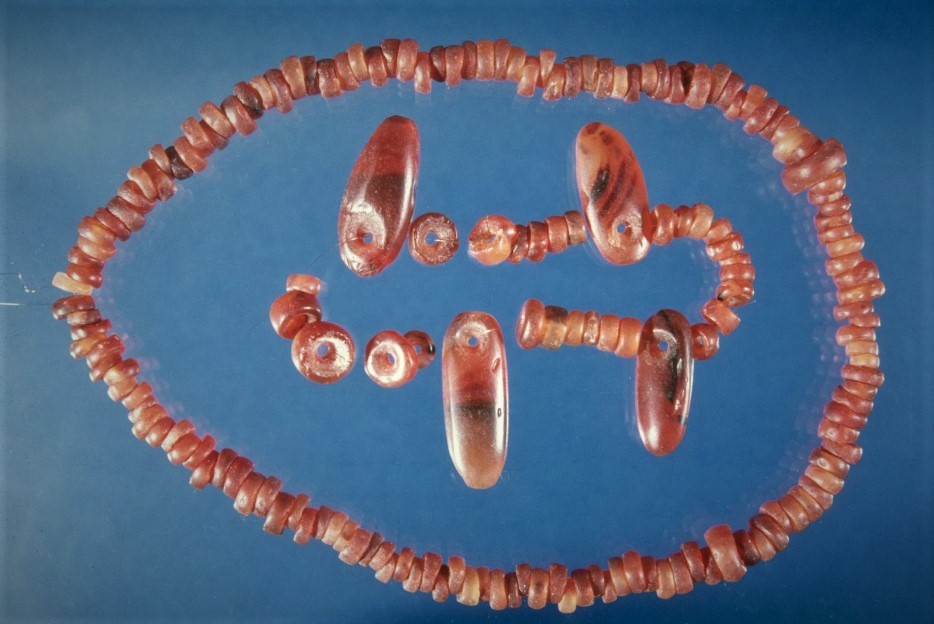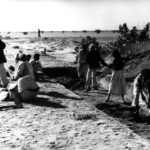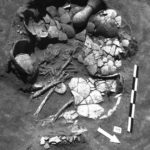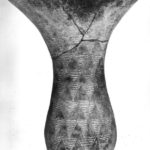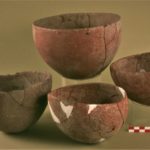Kadero
-
Project name:
-
Type of site:
Remains of a Neolithic settlement and cemetery and a Meroitic cemetery
Location:
Sudan
20 km north-east of Khartoum and 6.5 km east of the present-day riverbed of the NileDating:
– Khartoum Neolithic (from the second half of the 5th to the beginning of the 4th millennium BC)
– Meroitic period
– Medieval period(?)
Most interesting finds:
– Neolithic settlement (fragments of ceramic vessels, stone and bone implements, small personal adornments);
– Neolithic cemetery: almost 250 burials, including a few richly-furnished graves;
– Bones of domesticated animals, remains of plants that were probably cultivated;
– Remains of a Meroitic cemetery: relatively poor burials (presumably dating to the first half of the 1st millennium AD)
History of research:
Dates of PCMA mission’s work:
1972–2003
Type of research:
Excavations
Directors:
Lech Krzyżaniak (1972–2003)
Co-operating institutions:
– Polish Centre of Mediterranean Archaeology, University of Warsaw
– Archaeological Museum in Poznań
– National Corporation for Antiquities and Museums
Additional information:
The site was first recorded in 1940 by A. J. Arkell. In 1955, H. N. Chittick described the material collected from the surface and dated it to the Khartoum Neolithic.
Description of the site and research:
The research in Kadero was conducted under the aegis of the Centre of Mediterranean Archaeology of the University of Warsaw in Cairo (now Polish Centre of Mediterranean Archaeology, University of Warsaw) and the Archaeological Museum in Poznań. Seventeen excavation campaigns were carried out in the years 1972–2003 under the direction of Lech Krzyżaniak.
Both the Neolithic settlement and cemetery, in use at the same time, were studied. The settlement in Kadero is one of the best-recognized Early Neolithic sites in Sudan. It provided information on the natural environment as well as the daily life of its inhabitants, the economy, and the exchange of goods. About 250 burials were excavated in the cemetery, which is the only necropolis from that period in Sudan to be studied so comprehensively. The grave furnishings included ceramic vessels, jewelry, stone and flint tools, cosmetic utensils. Data acquired from the study of the necropolis allowed the reconstruction of the social structure of the inhabitants in the early phase of the Khartoum Neolithic.
The research was interdisciplinary and included anthropological analyses, among others.
Associated events:
Exhibition: Kadero zaginiony świat nad Nilem
Exhibition plate: 70 lat polskich wykopalisk w Egipcie i na Bliskim Wschodzie
Krzyżaniak, L. (2004). Kadero: Preliminary report, 2003. Polish Archaeology in the Mediterranean 15, 273–276
Krzyżaniak, L. (2002). Kadero: Preliminary report, 2001. Polish Archaeology in the Mediterranean 13, 227–233
Krzyżaniak, L. (2000). Kadero: Preliminary report, 1999. Polish Archaeology in the Mediterranean 11, 223–226
Krzyżaniak, L. (1998). Kadero: Excavations 1997. Polish Archaeology in the Mediterranean 9, 155–157
Krzyżaniak, L. (1994). Kadero 1993. Polish Archaeology in the Mediterranean 5, 111–114
Krzyżaniak, L. (1993). Kadero, 1991. Polish Archaeology in the Mediterranean 4, 94–97
Chłodnicki, M. (1987) Ceramics from the Neolithic Cemetery at Kadero – Central Sudan, Archeologie du Nil Moyen, 2, 141–147
Krzyżaniak, L. (1986). Kadero. In Z. Kiss (Ed.), 50 lat polskich wykopalisk w Egipcie i na Bliskim Wschodzie, Warszawa, 97–100
Dzierżykray-Rogalski, T. (1984). Remarks on the position of human Romains in the Neolithic Graves at Kadero (Central Sudan). In L. Krzyżaniak, M. Kobusiewicz (Eds.), Origin and Early Developement of Food-Producing Cultures in North-Eastern Africa, 33–335
Krzyżaniak, L. & Kobusiewicz, M. (Eds.) (1984). Origin and Early Developement of Food-Producing Cultures in North-Eastern Africa, Poznań
Promińska, E. (1984). The demography of the populations fron Kadero (Central Sudan). In L. Krzyżaniak, M. Kobusiewicz (Eds.), Origin and Early Developement of Food-Producing Cultures in North-Eastern Africa, 327–331
Krzyżaniak, L. (1979). Kadero (fourth-sixth, 1975-1976), Etudes et Travaux nr 11, 245–252
Krzyżaniak, L. (1978). New light on Early food-production in the Central Sudan, Journal of African History 19, 159–172
Dzierżykray-Rogalski, T. (1977). Neolithic Skeletons from Kadero, Current Anthropology 18, 595–596. Chłodnicki, M. (1982). Z badań nad ceramiką z osady neolitycznej w Kadero, Sudan, Przegląd Archeologiczny, 30, 81–117
Krzyżaniak, L. (1976). Kadero (second-third season, 1973-1973/4), Etudes et Travaux, 9, 283–287
Krzyżaniak, L. (1975). Kadero (first season, 1972), Etudes et Travaux, 8, 361–366
Krzyżaniak, L. (1968). Neolithic sites at Old Dongola (Sudan). Fontes Archaeologici Posnanienses, 19, 1–5
Chittick, H. N. (1955). Two Neolithic Sites Near Khartoum, Kush, 3, 75–81
Arkell, A. J. (1953). Shaheinab: an account of the excavation of a neolithic occupation site carried out for the Sudan Antiquities Service in 1949–50. London, Oxford University Press
Gallery:
-
1. Fieldwork in Kadero / Prace terenowe w Kadero (fot. Archiwum CAŚ UW)
-
2. Grave 113 at the beginning of exploration / Grób 113 na początku eksploracji (fot. Archiwum CAŚ UW)
-
3. Ceramic cup from grave 113 / Kubek ceramiczny z grobu 113 (fot. Archiwum CAŚ UW)
-
4. Carnelian jewelry from Neolithic graves / Biżuteria z karneolu, pochodząca z wyposażenia grobów neolitycznych (fot. Archiwum CAŚ UW)
-
5. Ceramic vessel from a Neolithic grave / Naczynia ceramiczne pochodzące z wyposażenia grobów neolitycznych (fot. Archiwum CAŚ UW)
-
6. Fieldwork in Kadero. Lech Krzyżaniak in the center / Prace terenowe w Kadero. W centrum Lech Krzyżaniak (fot. Archiwum CAŚ UW)
-
7. Fieldwork in Kadero / Prace terenowe w Kadero (fot. Archiwum CAŚ UW)

